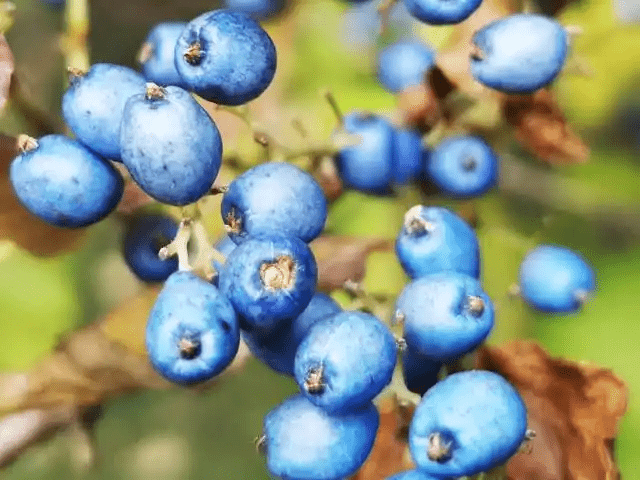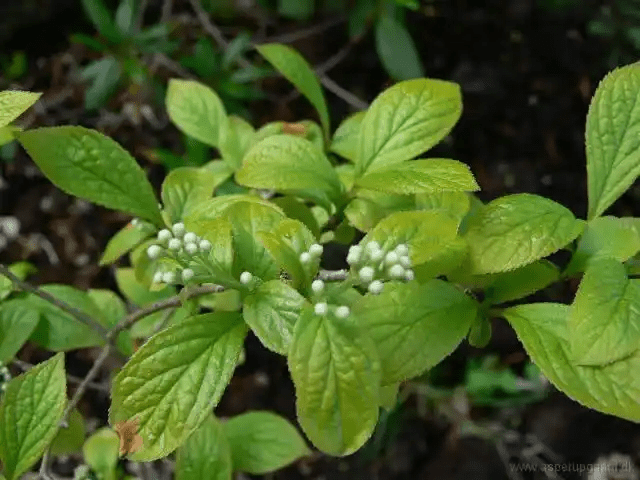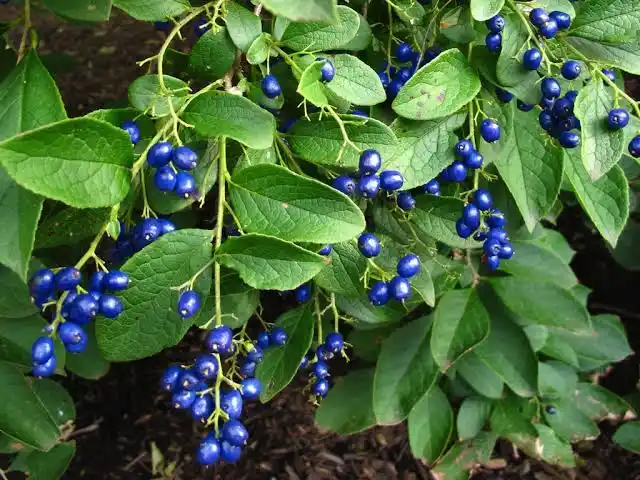Symplocos paniculata, commonly known as Sapphire-Berry, is a deciduous shrub or small tree belonging to the Symplocaceae family. Native to regions of Asia, including China and the Himalayan range, this plant is celebrated for its ornamental qualities, distinctive blue berries, and various uses in traditional medicine.
The Sapphire-Berry is characterized by its ovate to lanceolate leaves, which often have serrated edges. During the growing season, the plant showcases small, fragrant, white flowers arranged in panicles, contributing to its aesthetic appeal.
However, it is the vibrant, deep blue berries that emerge in late summer and fall that truly distinguish Symplocos paniculata. These sapphire-like fruits are not only visually striking but also add to the plant’s allure.
In addition to its ornamental value, Sapphire-Berry has a history of use in traditional medicine. Various parts of the plant, including the bark and leaves, have been employed for their potential therapeutic properties.
In traditional practices, extracts from Symplocos paniculata have been used for their astringent and anti-inflammatory qualities. The plant’s compounds are believed to have applications in the treatment of conditions such as diarrhea and skin ailments.
Cultivation of Sapphire-Berry is well-suited to temperate climates, and the plant thrives in well-drained soil with a preference for acidic to neutral pH levels. It generally prefers full to partial sunlight, and once established, it is considered relatively low-maintenance.
Propagation is typically done through seeds, and the plant can be cultivated in gardens, parks, and woodland settings. The striking blue berries contribute to its popularity in landscaping, adding a unique and colorful element to the natural surroundings.
In conclusion, Symplocos paniculata, or Sapphire-Berry, is a captivating plant with both ornamental and medicinal significance. Its attractive foliage, fragrant flowers, and distinctive blue berries make it a prized addition to gardens, while its historical use in traditional medicine adds to its cultural importance.
Whether appreciated for its visual appeal or explored for its potential therapeutic properties, the Sapphire-Berry stands as a notable and versatile botanical specimen.
The Botanical Description of Symplocos paniculata
1. Overview: Symplocos paniculata, commonly known as sapphire-berry, is a deciduous shrub or small tree belonging to the Symplocaceae family. It is characterized by its distinctive botanical features, making it an interesting subject for both botanists and nature enthusiasts.
2. Height and Structure: The plant typically reaches a height of 2 to 5 meters, presenting a compact and well-branched structure. The branches are often slender yet sturdy, contributing to the overall elegance of the shrub.
3. Leaves: The leaves of Symplocos paniculata are simple, alternate, and possess an elliptical to oblong shape. Their size ranges from 5 to 10 centimeters in length, and they exhibit a glossy, dark green color. The leaves play a crucial role in the plant’s photosynthetic processes.
4. Flowers: The flowering stage showcases small, fragrant, and attractive flowers. The blossoms are typically white or cream-colored, forming in panicles or clusters. This floral arrangement adds to the ornamental appeal of the shrub.
5. Fruits: One of the defining features of Symplocos paniculata is its berries. These berries, often referred to as sapphire berries, are small, spherical, and possess a striking blue color. The visual contrast between the white flowers and the vibrant blue berries contributes to the plant’s aesthetic allure.
6. Bark and Twigs: The bark of the sapphire-berry shrub is smooth, and the twigs are often reddish-brown. These characteristics add to the overall texture and visual interest of the plant, especially during the dormant season.
The Geographic Distribution of Symplocos paniculata
1. Native Range: Symplocos paniculata is native to a diverse range of regions, primarily found in parts of Asia. Its native habitat includes countries such as India, Nepal, Bhutan, Myanmar, and China. Within these regions, the shrub thrives in various ecological conditions.
2. Habitat Preferences: The sapphire-berry shrub exhibits adaptability to different habitats within its native range. It can be found in mountainous regions, often thriving in subtropical and temperate climates. The ability to grow in diverse environments contributes to the plant’s widespread distribution.
3. Altitudinal Range: Symplocos paniculata is known to inhabit a range of altitudes, from lower elevations to higher mountainous areas. This adaptability to varying altitudes contributes to its presence in ecosystems with different temperature and precipitation levels.
4. Cultivation Beyond Native Range: Due to its ornamental value, Symplocos paniculata has been introduced and cultivated in various parts of the world outside its native range. Botanical gardens and horticultural enthusiasts appreciate its aesthetic qualities, leading to its cultivation in diverse climates.
The Chemical Composition of Symplocos paniculata
1. Phytochemicals: Symplocos paniculata is rich in phytochemicals, which are naturally occurring compounds with potential health benefits. These include flavonoids, alkaloids, tannins, and phenolic compounds. These phytochemicals contribute to the plant’s medicinal properties.
2. Antioxidant Compounds: The shrub contains antioxidants that play a crucial role in neutralizing free radicals within the body. Antioxidants contribute to overall health by reducing oxidative stress and inflammation.
3. Medicinal Alkaloids: Certain alkaloids present in Symplocos paniculata may have medicinal properties. Alkaloids are known for their diverse biological activities, including potential anti-inflammatory and analgesic effects.
4. Tannins and Their Benefits: The presence of tannins in the plant contributes to its astringent properties. Tannins have been associated with various health benefits, including anti-diarrheal effects and potential wound healing properties.
5. Traditional Uses: In traditional medicine systems, various parts of Symplocos paniculata, including leaves and bark, have been utilized for their medicinal properties. These traditional uses include remedies for gastrointestinal issues, skin conditions, and as an overall health tonic.
6. Essential Oils: While not as extensively studied as in some aromatic plants, Symplocos paniculata may contain essential oils. These oils can have therapeutic applications, contributing to the plant’s overall chemical composition.
Understanding the botanical description, geographic distribution, and chemical composition of Symplocos paniculata provides a comprehensive insight into the characteristics and potential uses of this intriguing plant.
Whether appreciated for its aesthetic appeal or explored for its medicinal properties, the sapphire-berry shrub stands as a fascinating botanical specimen.
Read Also: 7 Medicinal Health Benefits Of Ribes divaricatum (Straggly Gooseberry)
The Medicinal Health Benefits Of Symplocos paniculata (Sapphire-Berry)

1. Anti-Inflammatory Properties: Symplocos paniculata exhibits potent anti-inflammatory effects, beneficial for conditions like arthritis and inflammatory bowel diseases.
2. Antioxidant Action: The plant’s antioxidant compounds neutralize free radicals, lowering the risk of chronic diseases and contributing to overall health.
3. Gastrointestinal Health: Addresses digestive issues, such as indigestion and bloating, promoting a healthy digestive system.
4. Skin Conditions: Offers relief for skin conditions like eczema and dermatitis, thanks to its anti-inflammatory and soothing effects.
5. Respiratory Support: Traditionally used for respiratory issues, including coughs, bronchitis, and asthma.
6. Antipyretic Effects: Exhibits antipyretic properties, aiding in reducing fever and addressing febrile conditions.
7. Women’s Health: Regulates menstrual cycles and addresses conditions like dysmenorrhea and menopausal symptoms.
8. Antidiabetic Potential: Shows potential antidiabetic effects, contributing to blood sugar regulation and diabetes management.
9. Cardiovascular Support: Antioxidant and anti-inflammatory properties contribute to cardiovascular health, reducing the risk of heart-related issues.
10. Analgesic Properties: Offers pain relief for conditions causing discomfort, enhancing overall well-being.
11. Liver Health: Supports liver health and promotes detoxification processes for optimal liver function.
12. Anti-Diarrheal Effects: Traditionally used to address diarrhea and related gastrointestinal disturbances.
13. Wound Healing: External applications aid in wound healing, supported by anti-inflammatory and antimicrobial properties.
14. Immune System Support: Regular use enhances the immune system, providing better protection against infections and illnesses.
15. Anticancer Properties: Preliminary studies suggest potential anticancer properties, warranting further exploration in cancer research.
16. Anti-Aging Effects: Antioxidant content contributes to anti-aging effects, protecting the skin and body from premature aging.
17. Neuroprotective Potential: Emerging research indicates neuroprotective effects, with implications for cognitive health and neurological conditions.
The Methods of Usage to Achieve the Provided Health Benefits Of Symplocos paniculata (Sapphire-Berry)
1. Infusions and Teas: Prepare infusions or teas using dried leaves or berries for internal consumption.
2. Powdered Form: Grind dried plant material into a powder, encapsulating it for controlled dosage.
3. Topical Applications: Create ointments or creams using extracts for skin-related benefits and wound healing.
4. Tinctures: Use alcohol-based tinctures for concentrated internal use, preserving the plant’s medicinal properties.
5. Decoctions: Boil plant parts in water to create decoctions, suitable for extracting less water-soluble compounds.
6. Capsules and Tablets: Incorporate Symplocos paniculata into health regimens through commercially available capsules or tablets.
7. Traditional Formulations: In regions with a history of traditional use, employ specific formulations passed down through generations.
The Side Effects Of Using Symplocos paniculata Medicinal Plant
1. Allergic Reactions: Caution for individuals with allergies to the Symplocaceae family, as allergic reactions may occur.
2. Gastrointestinal Discomfort: Excessive consumption or improper preparation may lead to gastrointestinal discomfort, including nausea.
3. Skin Sensitivities: Topical applications may cause skin sensitivities; perform a patch test before widespread use.
4. Interactions with Medications: Consult healthcare professionals, especially for diabetes or blood pressure medications, due to potential interactions.
5. Pregnancy and Lactation: Pregnant or lactating individuals should seek medical advice before using Symplocos paniculata due to potential effects.
Read Also: How to Choose the Right Crops for your Climate
The Scientific Research and Studies of Symplocos paniculata (Sapphire-Berry)

1. Phytochemical Analysis: Numerous scientific studies have focused on the phytochemical composition of Symplocos paniculata, identifying compounds like flavonoids, alkaloids, and tannins.
2. Anti-Inflammatory Properties: Research indicates that Symplocos paniculata exhibits anti-inflammatory effects, modulating pathways relevant to chronic inflammation.
3. Antioxidant Capacity: Scientific investigations explore the antioxidant capacity of the plant, attributing its ability to combat oxidative stress and neutralize free radicals.
4. Antimicrobial Activity: Studies suggest that Symplocos paniculata extracts possess antimicrobial properties, showcasing inhibitory effects against various microorganisms.
5. Anticancer Potential: Preliminary research hints at the plant’s potential anticancer properties, necessitating further exploration in cancer treatment.
The Safety Precautions and Recommendations In Using Symplocos paniculata (Sapphire-Berry) Medicinal Plant
1. Allergic Reactions: Caution for individuals with allergies to the Symplocaceae family to prevent potential allergic reactions.
2. Dosage Considerations: Adhering to recommended dosages is crucial, and consulting healthcare professionals ensures personalized guidance.
3. Pregnancy and Lactation: Pregnant or lactating individuals should seek medical advice before using Symplocos paniculata due to potential effects on reproductive health.
4. Interactions with Medications: Consult healthcare professionals, especially for diabetes or blood pressure medications, to avoid potential interactions.
5. Skin Sensitivity: Perform a patch test before widespread use, as topical applications may cause skin sensitivities in some individuals.
6. Children and Elderly: Special consideration for children and the elderly, with dosages possibly needing adjustment; seek professional advice.
7. Medical Conditions: Individuals with specific medical conditions, such as diabetes or cardiovascular issues, should consult healthcare providers before incorporating Symplocos paniculata into their health regimens.
FAQs About Symplocos paniculata (Sapphire-Berry) Medicinal Plant
1. Is Symplocos paniculata safe for pregnant women?
Pregnant women should consult healthcare professionals for safety considerations during pregnancy.
2. Can Symplocos paniculata be used for children?
Dosages for children may require adjustment, and consulting healthcare professionals is recommended.
3. Are there any known drug interactions with Symplocos paniculata?
Consult healthcare professionals to assess potential interactions, especially with existing medications.
4. How should Symplocos paniculata be stored?
Store products in a cool, dry place away from direct sunlight, following specific recommendations for commercially available formulations.
5. Can Symplocos paniculata be used for skin conditions?
Topical applications may aid in addressing various skin conditions, but a patch test is recommended for potential sensitivities.
6. What is the recommended dosage for Symplocos paniculata supplements?
Follow product-specific recommendations and consult healthcare professionals for personalized guidance on dosage.
7. Is there a risk of addiction or dependency with Symplocos paniculata use?
There is no evidence suggesting addiction or dependency with proper use for medicinal purposes.
8. Can Symplocos paniculata be used as a substitute for conventional medical treatments?
It can complement conventional treatments but should not replace them; consult healthcare professionals for a comprehensive healthcare approach.
9. Are there any dietary restrictions while using Symplocos paniculata?
No specific dietary restrictions are associated with its use, but maintaining a balanced diet is advisable.
10. How long does it take to experience the health benefits of Symplocos paniculata?
The time to experience benefits varies based on individual factors, health conditions, and the form of the supplement used.
11. Can Symplocos paniculata be used for chronic conditions?
Consistent and prolonged use may be necessary for chronic conditions; consult healthcare professionals for proper management.
12. Are there any known contraindications for Symplocos paniculata use?
Individuals with known allergies to the Symplocaceae family should avoid its use; consult healthcare professionals for specific health concerns.
13. How should I discontinue the use of Symplocos paniculata if needed?
Gradually reduce the dosage under the guidance of healthcare professionals to minimize potential withdrawal effects if discontinuation is necessary.
Read Also: How Supporting Farmers Can Benefit Our Communities

